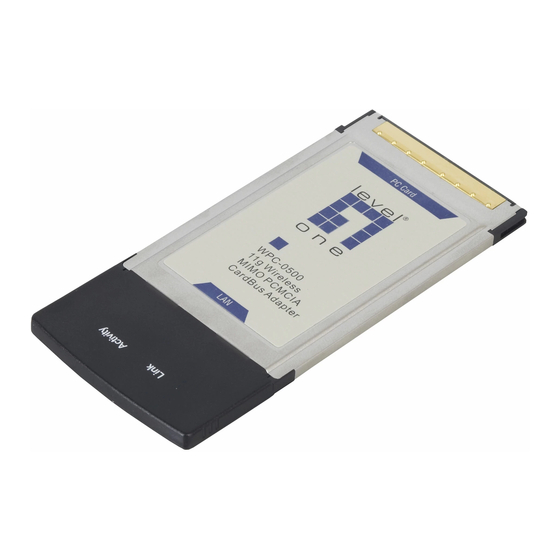Table of Contents
Advertisement
Quick Links
Download this manual
See also:
User Manual
Advertisement
Table of Contents

Summary of Contents for LevelOne WPC-0301
-
Page 1: User Manual
WPC-0301 11g Wireless PCMCIA Adapter USER MANUAL... -
Page 2: Table Of Contents
Contents Introduction......................3 Product Feature ..................3 System Requirement ................3 Getting Start ......................3 LED Indicators..................3 Install the 802.11g Wireless Network PCMCIA Adapter ......4 2.2.1 Utility Installation ................4 2.2.2 Driver Installation ................6 3. Configuration ......................9 3.1 Link Information....................9 3.2 Configuration ....................10 3.3 Encryption......................11 3.4 Site Survey .....................12 3.5 About US......................14 4. -
Page 3: Introduction
1. Introduction Congratulations on your purchase of this outstanding LevelOne WPC-0301, 11g Wireless PCMCIA Adapter. By 802.11g standard, WPC-0301 provides the stable wireless connection up to 54Mbps. LevelOne brought to you the most convenient and efficient wireless environment. Please refer to this manual before your installation. -
Page 4: Install The 802.11G Wireless Network Pcmcia Adapter
2.2 Install the 802.11g Wireless Network PCMCIA Adapter 2.2.1 Utility Installation Before insert WPC-0301 into the PC cardbus of your computer, please install the Utility Program first. Make sure that the 802.11g wireless Network PCMCIA Adapter is NOT inserted into the cardbus slot. - Page 5 InstallShield Wizard will automatically start. Please click “Next” to continue.
-
Page 6: Driver Installation
Please click “Finish” Please turn off your computer and then insert the WPC-0301 into the cardbus. Turn on your computer and start to install the driver. 2.2.2 Driver Installation 1. Please select the first option and click “Next”. - Page 7 2. Please click “Continue Anyway” 3. Please click “Finish”...
- Page 8 4. To make sure if the installation is successful, you could check it through the device management. 5. Once the installation is successful, a utility program icon will show on your desktop. To lunch the utility, just double click the icon.
-
Page 9: Configuration
3. Configuration 3.1 Link Information The default page is as below after you launch the Utility program. Status: Shows the BSSID associated, which can be used to identify the wireless network. SSID: Shows current SSID, which must be the same for the wireless client and AP in order for communication to be established. -
Page 10: Configuration
●Continuous Access Mode (default) – the WPC-0301 is constantly operating with full power and it consumes the most power. ●Maximum Power Save – the WPC-0301 consumes the least power and only operates when there is wireless network activity. ●Power Save – the WPC-0301 consumes the moderate level of power. -
Page 11: Encryption
transmitted at 1Mbps that allows the PHY circuitry to reach steady-state demodulation and synchronization of bit clock and frame start. Two different preambles and headers are defined: the mandatory supported Long Preamble and header, which interoperates with the 1 Mbit/s and 2 Mbit/s DSSS specification (as described in IEEE Std 802.11), and an optional Short Preamble and header (as described in IEEE Std 802.11b). -
Page 12: Site Survey
Open Authentication – the sender and receiver do not share secret Key for communication. Instead, each party generates its own key-pairs and asks the other party to accept it. The key is regenerated when the connection is established every time. Shared Authentication –... - Page 13 Available Network – displays the wireless networks (wireless clients and Access Points) that are in your signal range. Select any one of them to establish communications by simply mouse double-click or click on the “Connect” button. Click “Refresh” button to start scanning for available network again. Profile –...
-
Page 14: About Us
3.5 About US This page displays some information about the 54Mpbs wireless LAN PCMCIA Adapter utility, which includes the version numbers for Driver, Firmware and Utility. When there is new version of software available for upgrade, you will be able to identify by version numbers. - Page 15 supported by the Access Point: 1. Open System: Open System authentication is the simplest of the available authentication algorithms. Essentially it is a null authentication algorithm. Any station that requests authentication with this algorithm may become authenticated if 802.11 Authentication Type at the recipient station is set to Open System authentication. 2.
- Page 16 DHCP: Dynamic Host Configuration Protocol, which is a protocol that lets network administrators manage and allocate Internet Protocol (IP) addresses in a network. Every computer has to have an IP address in order to communicate with each other in a TCP/IP based infrastructure network. Without DHCP, each computer must be entered in manually the IP address.
- Page 17 communication protocols. HEX: Hexadecimal, HEX, consists of numbers from 0 – 9 and letters from A – F. IEEE: The Institute of Electrical and Electronics Engineers, which is the largest technical professional society that promotes the development and application of electrotechnology and allied sciences for the benefit of humanity, the advancement of the profession.
- Page 18 RTS: Request To Send. An RS-232 signal sent from the transmitting station to the receiving station requesting permission to transmit. RTS Threshold: Transmitters contending for the medium may not be aware of each other. RTS/CTS mechanism can solve this “Hidden Node Problem”. If the packet size is smaller than the preset RTS Threshold size, the RTS/CTS mechanism will NOT be enabled.













Need help?
Do you have a question about the WPC-0301 and is the answer not in the manual?
Questions and answers